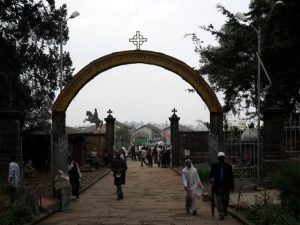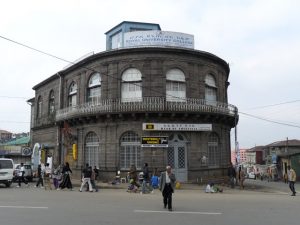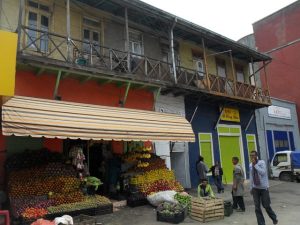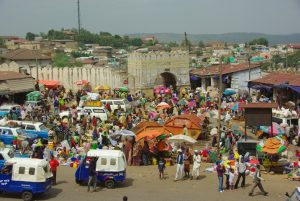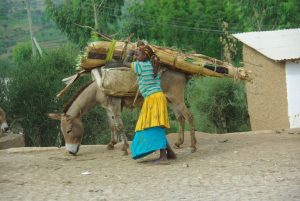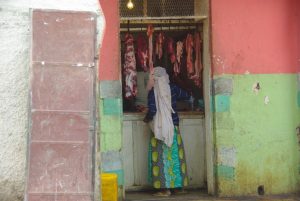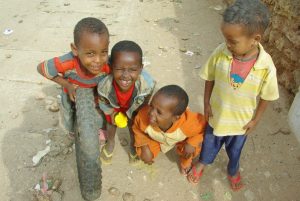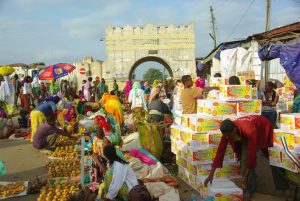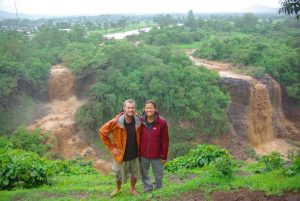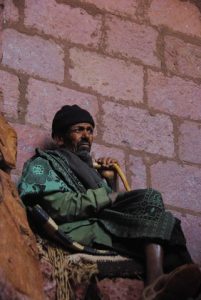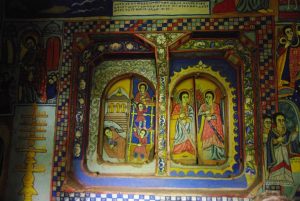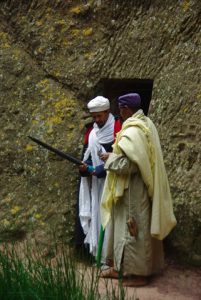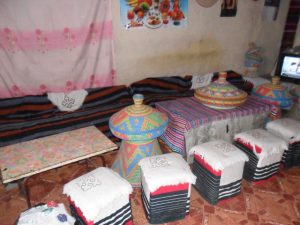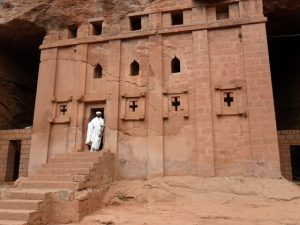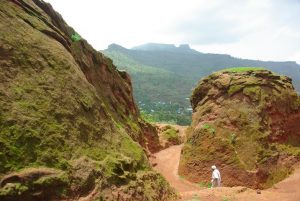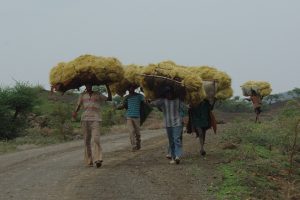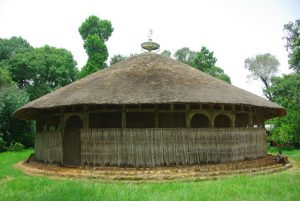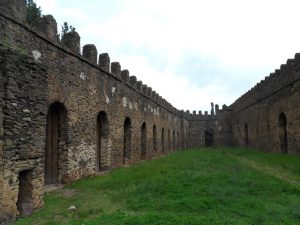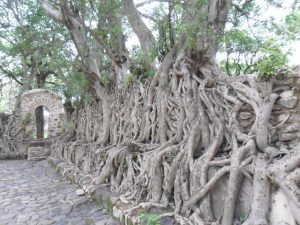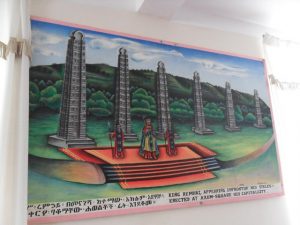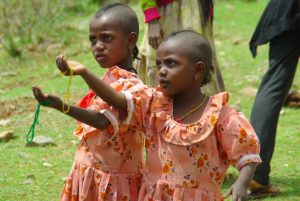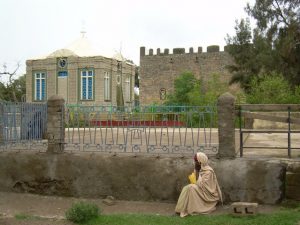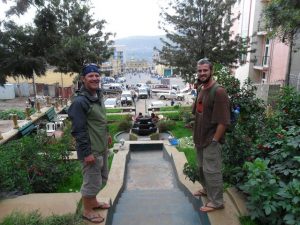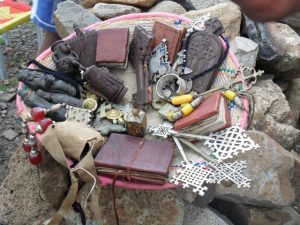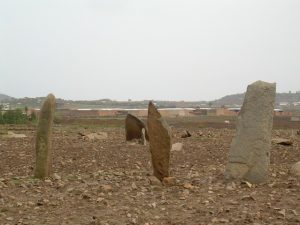From the moment we landed at the Addis Ababa International Airport, we knew Ethiopia would be unlike any other country we had visited in Africa. Our first impression of the capital city was actually quite negative – a sprawling metropolis where we were accosted immediately by street touts who had perfected the line of “Give me ___”. Pushing these persistent annoyances aside, we braved our way through the city and visited the merkato (supposedly Africa’s largest open air market), St George’s Cathedral, imbibed on tej (honey wine) at the Addis Ababa Restaurant, and frequented many of the city’s excellent restaurants eating affordable meals. From Addis, we escaped to Harar, Islam’s 4th most holy city. Harar is an explosion of colors, sights and sounds and we really loved this walled city, where our evening entertainment consisted of the age old tradition of feeding hyenas up close and personal. From Harar, we backtracked to Addis and then drove onward to Bahir Dar, where a quick trip to Tis Abay Falls “the water that smokes” was in order. We used Bahir Dar as our base for an excursion to Lalibela, the world famous rock hewn churches which are indelibly burned into our memories…simply phenomenal. Afterwards, we visited Lake Tana’s famous monasteries which wowed us with their colorful religious paintings. Then it was onward to Gondar, reputedly “the Camelot of Africa”. The Royal Enclosure and Fasilidas Baths are well worth a visit. From Gondar, we flew to Axum, home to the world’s largest obelisk and the ark of the covenant. Back at Gondar, we opted for a day trip to the Simien Mountains which were breathtakingly beautiful despite it being rainy season. A chance to view the rare gelada monkey in the mountains remains a highlight. From Gondar, it was a quick drive to Sudan, which brought our visit to Ethiopia to an end. Whoever came up with the tourist slogan “13 months of sunshine” has obviously never visited Ethiopia during rainy season! Nevertheless, this was a fantastic visit to one of Africa’s most fascinating countries.
9 Jul: It was just after 5 am when we landed at the Addis Ababa international airport and the first curveball that airport staff threw us was demanding to see our yellow fever vaccination cards. Luke of course didn’t bring his, and he was pulled out of the queue to see the authorities. The rest of us got entry visas (US $20) upon arrival and got stamped into Ethiopia with no problems. Apparently Luke had to purchase another yellow fever document (for US $4) so essentially he was let off with a slap on the wrist. Becky had wished that his punishment would have been a bit more severe to force him to come to grips that crossing borders and having the necessary documentation is no joke, but of course he managed to weasel his way through without having learned a valuable lesson. After retrieving our luggage, it was an exercise in patience as we slowly made our way to the baggage screening area, and finally, welcome to Ethiopia! Our taxi ride from the airport to the Taitu Hotel was negotiated down to 125 Birr per taxi of three (at a rate of 16.9 Bir to the US$) and within minutes, we were at the piazza. The hotel staff confused us by telling us that check out was at 5 am, and Ally kept trying to reason with the receptionist, informing her that it was now 7:30 am, so 5 am had come and gone. The receptionist was fairly brusque in brushing us all off and telling us to wait around until checkout, and after over an hour, Ally attempted to get down to the bottom of what 5 am really was. Apparently, there is “Ethiopian” time, which is six hours off from real time. So when the hotel receptionist was claiming a 5 am checkout, she actually meant an 11 am checkout. It was really frustrating dealing with the Taitu staff who were not helpful nor forthcoming with information. Realizing that we would not get a room before 11 am, we finally asked for the room numbers of either Laura/Lydia or Mel/Itchiyo and the staff refused to give that information out. However, persistence paid off and eventually, we linked up with Mel who told us that her time in Ethiopia had been quite horrible (on her first night in town, some men tried to rape her, she got food poisoning, and the hotel facilities were quite unhygienic with shit smeared on the walls of the common area bathroom that was on her floor. It was not shaping out to be a positive experience in Addis as our own initial reception had been less than positive! A group of us headed out for some breakfast in an attempt to kill time and we ordered injera (a foam rubber bread which tastes like fermented yeast) which is a traditional Ethiopian meal. Afterwards, we wandered the streets of Addis Ababa and for the first time in many months, were mercilessly accosted by beggars, touts, and harassing children of every description. Unbelievable! Addis Ababa has not proved to be welcoming thus far, and our first impressions of the city are highly negative. Undeterred, we talked to several travel agents to scope out the highlights of Addis for a potential city tour, and all but one of the agents proved to be quite worthless in providing information. By 11 am, we were finally given a room (at the cost of 162 Birr a night) and by 11:30 am, Becky was back down in reception to inform them that her bed had collapsed, with one of its legs snapping off. After being told to “wait and someone will come take a look at it”, our tempers were short when at noon, no one had shown up to check it out. Robby went back down to reception not once, but a total of three times and finally, over an hour after informing the staff of our unacceptable room situation, we managed to swap rooms to a better one located on the first floor of the budget annex. We were weary when we finally rested our heads and within minutes, were knocked out for a few hours of sleep. Robby only allowed us two hours of sleep as he didn’t want our sleep cycle to get out of whack, so by early afternoon, we were up. At 6 pm, we headed out to grab a quick dinner with Lucky and Ally at a nearby hotel restaurant (Wutma Restaurant) that had caught our eye. The lasagna was great, and Robby enjoyed the draft beer on tap. Our meal including a chicken soup appetizer came out to about $6 USD for the two of us, making Ethiopia a destination with great value for our money. Back at the Taitu, water was barely trickling for the sinks, showers and toilets so Becky took a bird bath before crawling back into bed to get a bit more shut eye.
10 Jul: Lucky knocked on our door at 8 am and we joined him and Ally for breakfast at Wutma Restaurant since we had enjoyed it so much the night before. Ally ordered French toast which was quite tasty with a strawberry syrup, while Becky ordered mincemeat with eggs on toast. Lucky got fried eggs and Robby got the full breakfast, so we all ate to our heart’s content. After breakfast, our main goal was to find a place where we could get our passports and visas photocopied, but it was quite a quest to do so as everything appeared to be closed on a Sunday. Robby befriended a street tout named Daniel, and we were all impressed with his English speaking skills. Since he was being so helpful and friendly, we briefly contemplated hiring him as our city guide for the day. However, when we suggested it, Daniel was reluctant to accept any payment for his services because, as he explained to us, he preferred to use this opportunity to practice his English as that meant more to him than any financial compensation. We briefly returned to Hotel Taitu to drop off our photocopies, and Daniel asked us if we knew the significance of the hotel we were staying in. Admitting our ignorance, he explained that the piazza Hotel was built in 1898 by Empress Taitu (Emperor Menelik’s wife). It is Addis Ababa’s oldest and most famous hotel, and he suggested that we walk the interior of it later when we got a chance. From Hotel Taitu, Daniel led us to the merkato (reputedly one of Africa’s largest open air markets). It was rather subdued but considering that today is Sunday and most of the shops and stalls were closed, the absence of shoppers was understandable. The most lively section was the clothing market, as shoppers appeared to converge from out of nowhere, transforming the sleepy section into a bustling and frenetic area. An armed policeman spotted us with our cameras and he warned Daniel to advise us to keep a close eye on our valuables. Then, he proceeded to escort us faranjis (foreigners) all around the market, ensuring that no potential robbers got too close to us! The market was quite large, and consisted of numerous sections such as the meat, cheese, honey, fruit and vegetable, clothing, spice, and traditional arts and crafts. After the merkato, we walked over to St George Cathedral, which is an imposing edifice that was built in 1896 to commemorate the Battle of Adwa (where the Ethiopians defeated the Italians). Unfortunately, the adjacent museum was closed for lunch, so we decided to come back after a quick meal. Daniel recommended that we eat lunch at a traditional Ethiopian restaurant, so we walked over to the Addis Ababa Restaurant where we were impressed by the traditional ambience and décor. Our meal was amazing, consisting of beef ribs, chicken in a spicy chili sauce, injera, and topped off with honey wine (tej). The meal was extremely fulfilling and our bill came out to $3 a person for the five of us. Great value! Daniel did explain that since the restaurant is in Lonely Planet, it is packed at night, so we were better off eating lunch since it is impossible to get a seat later on in the evening. While we were eating lunch, it poured down cats and dogs, so we waited for the rain to subside before splitting off into two groups. Lucky and Ally had enough so they were heading back to Hotel Taitu, and we were keen on visiting St George’s Cathedral and museum. The admission into the museum was 20 Birr, and our guide unlocked the cathedral and gave us a personalized tour. He played music and sang and danced for us, allowed us to take photos of the paintings inside the cathedral, and explained so much of the history of Ethiopia to us. We learned that the country’s first capital was in Aksum (where the covenant of the ark currently resides), the second capital was Gondar, and the third (and current) capital is Addis Ababa. Photography inside the museum was not allowed, but the relics were fascinating and our guide kept up an informative briefing, which kept our interest in the displays. Photographs of the rock hewn churches of Lalibela were on display and Daniel gave us a prelude of what is to come by explaining the layout and highlights of the region (he hails from Lalibela). We were quite satisfied with our city tour and bid Daniel farewell after arranging another excursion with him for tomorrow morning. It was at this point that he asked us if we would consider “helping him out” with a financial compensation, and while awkward, we didn’t mind giving him some money as we had been more than happy to pay him for his guiding services. It was just weird since we had tried to establish a price with him first thing in the morning and he had declined, but somehow over the course of the day he obviously must have changed his mind. We ended up giving him a total of 200 Birr (50 Birr from each of us) and thanked him for his services. The rest of Oasis strolled in as we were heading down to our rooms, so we greeted Lisa, Dowelly, Chris and Fi before getting our paperwork for the Sudan visas organized. At 5 pm, Nancy walked us through filling out the Sudanese Visa paperwork, and along with passport photos, copies of our Egyptian and Ethiopian visas and $150 each, we handed in the necessary paperwork and crossed our fingers that all would go well. Mel and Becky discussed the option of hiring a van to take us to Harar, and after negotiating with a travel agent, got a 8 pax van with driver and two full days of driving for $320 ($40 each assuming 8 people). Mel, Itchiyo, Damien and Anna were keen on going but everyone else either didn’t want to endure the long drive days or didn’t have the necessary funds so it ended up being just the 6 of us going. We headed over to a nearby pizza joint for dinner, but Robby wasn’t keen on pizza so he and Lucky ate elsewhere, leaving Becky to enjoy an all girls night with Itchiyo and Mel. Since we had an early 4 am pick up to Harar tomorrow, we went to bed early, trying to get a bit of shut eye.
11 Jul: The alarm sounded way too early at 3:30 am. We rushed around trying to get any last minute packing accomplished and loaded our unnecessary gear onto the truck before meeting our driver, Henok at 4 am. Thank God only 6 of us had agreed to the tour as we immediately found out that the seats were not that comfortable and it was much easier to lay out on the floor. We caught a few extra hours of sleep sprawled out on the floor of the van, and awoke to breakfast at 8 am in a small hotel enroute to Harar. To our surprise, the hotel restaurant had neither coffee nor tea on offer, and they messed up everyone’s order (instead of one scrambled eggs with bread and four meat/egg combos, they ended up with four plain scrambled eggs and one meat/egg combo). Becky opted to eat her leftover pizza from last night as breakfast, so she sat giggling at the order fiasco. After breakfast, we were back on the road again, and by noon we had arrived to Harar where a local guide/tout named Hamdi jumped into our van to show us where several accommodation options were. We were a bit put off at having him forced upon us, and everyone was leery that our room prices would increase as a result of agreeing to his assistance, but since he knew his way around the old city and we did not, we were at his mercy. The first guesthouse we looked at in the old city was quite scenic, built in a traditional Harari style. A room with a double bed went for 300 Birr including breakfast, and it looked quite nice. However, we were disappointed when we were told that the other available room, with two twin beds, was to accommodate four people and the going rate for that room was 600 Birr. The price and sleeping logistics were unacceptable, and we tried to compromise by agreeing to sleep in the main reception/dining area which was quite picturesque. However, the owner kept demanding 600 Birr for 4 people to share a common space, which offered virtually no privacy so we eventually declined and asked to be taken to hotel options in the new town. Hamdi suggested the Belayneh Hotel, which cost 225 Birr for a double room, not including breakfast. The view overlooking the old city (the Belayneh Hotel, while in the “new” city, is just a few seconds walk from the old city) were magnificent and we all agreed to stay here. Hamdi informed us that the hyena feeding would occur nightly at around 6:30 pm, and he suggested that we have Henok meet back to pick us up around 6 pm, as the headlights from the vehicle would be necessary to light up the feeding area. We agreed to link back up at 6 pm, and since it was now about 2 pm, had about 4 hours to explore the old city. The new camera that we had just bought mere days ago started acting up to our chagrin. What is it with Africa and our freaking cameras??? It is so frustrating to buy a camera that stops functioning just days after purchase. Our initial impression of Harar is that it is a colorful and vibrant city, with a riot of sights and sounds hitting our senses. Robby climbed up a building that offered a bird’s eye view of the old city, and the locals didn’t seem to mind seeing our camera lenses in the slightest. The old city was filled with donkeys carrying goods to and fro, and children would beg us to snap their photos. We ended up splitting from the group as Robby was in a finicky mood today, and we ended up wandering down remote back streets of the old city in an attempt to get lost. The meat market section was quite interesting, and some of the narrow lanes had brightly painted walls lining them. A lady was frying up samosas and after a mistranslation, we ended up with a whopping 20 samosas for 10 Birr. They tasted great fresh and hot, and provided us with a bit of fuel since we had skipped lunch to sightsee. We visited the old king Haile Selassie’s palace which has now been converted to the “Sherif Harar City Museum”, a cultural museum. The locals refer to this building as the former Ras Teferi building, in honor of Haile Selassie. There were some displays of old coins, medals, swords and weaponry, and traditional clothes, but the best part of our visit was climbing up to the second floor for a view out overlooking the city. Since it was nearing 6 pm, we headed back to the hotel for a quick drink before linking up with the rest of the group for our evening excursion out to see the hyena feeding. Henok drove us out to the outskirts of the city where a young man was calling out to the hyenas. We went for a walk to see the khat fields, and noticed a shadow slinking behind us, our first hyena encounter at close proximity! It was with a sense of excitement that we headed back up towards the village, and sure enough, hyenas started showing up. One of them was actually in the village dumpster scrounging around for food. By 6:45 pm, the feeding started and everyone was eager to volunteer “feeding” the hyenas. Becky fed a couple before getting jumped on by an overeager hyena which was pouncing on her back. Robby’s hyena feeding session was equally as memorable, and we marveled that we could get this close to wild hyenas and that this tradition has been ongoing for almost 100 years. The fee for watching and participating with the hyenas was 100 Birr each, and afterwards, Hamdi recommended that we try an omelet pancake from a street side vendor who was conducting brisk business with a long line of locals. It took a while for our orders to be processed, but the wait was worth it as the pancakes were delicious and a bargain at only 10 Birr a piece. Back at the hotel, Robby was keen on having veal and Damien wanted to try fried goat, so we joined them up at the restaurant and chatted with Ichiyo who ordered spaghetti. She was a bit disappointed with her meal as it was advertised as “spaghetti with meat” and sure enough, she got a plateful of pasta served alongside a bowl of meat. How bizarre that no tomato sauce was included! Since water at the hotel was only running from 6 – 10 pm, we didn’t have much time to take a shower, and when we did, it was cold. The constant water shortage in Ethiopia is an issue we would quickly grow tired of if we were to live here! Our overall impression of Harar, a city that was founded in 1520 and is considered the 4th most holy city in Islam, is overwhelmingly positive. It was well worth the extra expense and time to make the trip out here and we would have been gutted to have missed this opportunity.
12 Jul: Becky awoke to multiple flea bites thanks to her encounter with the hyenas last night. Oh well, it is a pretty unique Harar souvenir! We linked up with the rest of the group for breakfast up the street next door to Central Hotel, where we ordered the fried dough with honey dish. As promised by Hamdi, it was delicious and we could tell the joint was quite popular with the locals as it was packed, and when we first arrived, it was standing room only. Service was quick, polite and attentive, and we made it back to the Belayneh Hotel before our 8 am city tour with Hamdi. Since we weren’t sure what time our city tour would end, we decided to leave our baggage at reception and check out. Hamdi and Henok were running a bit late, but he pulled up at 8:20 and we started our tour, heading directly to one of Harar’s 72 King’s tombs. The tomb of Said Ali is painted turquoise blue, and it is nestled in the midst of a hilly area overlooking the old city of Harar. We actually climbed up the hillside to get a magnificent panorama of the city, and it helped give us perspective on just how big this city of 100,000 inhabitants is. Turquoise tombs dotted the landscape of the city, and we could distinctly make out the medieval wall surrounding the old city in its entirety. From our lookout point, we descended back down to the main road and drove into the old city via its main gate (complete with a UNESCO world heritage symbol) and headed for the khat market. Locals were busy buying and selling the green plant, and we were offered some to try (and refused, after our first and last taste in Yemen). Nearby was a cattle market with large humped bulls and cows were for sale. The “hyena man” from last night doubles as a cattle seller, and he jokingly offered us a cow for sale. Next on our tour was a visit to the Greek Cemetery, where burial plots are strewn throughout the area. A quick visit to a school was next on our itinerary, but the schoolmaster was perturbed that we might disturb the children’s studies so we didn’t linger too long. From the school, we continued on to the Arab quarter, where camel meat was hanging in the meat market for sale. Damien was keen on trying camel meat, but he didn’t have the opportunity. We were keen on visiting a traditional house, so Hamdi took us to his aunt’s house which is a typical Arab house. Her house is in a beautiful setting, and opposite is a typical Harari house, but her neighbor wasn’t in so we weren’t able to visit. Next on our tour was a glance at the oldest mosque in Harar, the 500 year old Egyptian Mosque. On our walk back towards the Belayneh Hotel, Becky stopped at a local shop to buy a traditional Harari basket, which she was able to bargain down from 280 Birr to 100 Birr. It is a lovely woven piece that will look great either as a fruit or bread basket or simply hanging on the wall. The walk back through the old city was quite picturesque, as the daily market was in full swing. We will definitely miss the sights, sounds and smells of Harar’s old city. After exiting the Asmaeiin Bari gate, we headed towards the Belayneh Hotel where we grabbed our bags, had a quick pee break and tipped Hamdi for his guiding services. He proved to be a nice, reliable and kind guide and we wished we been a little nicer to him yesterday, when we were all a bit skeptical about him being thrust upon us. From Harar, we started the long drive back towards Addis Ababa, which is almost 550 KM away. It was a long afternoon, with numerous police checkpoints and lots of cattle on the road. Henok was excellent, paying attention to the numerous road obstacles and maneuvering us expertly past them. By midafternoon, we pulled into a rest stop near Awash National Park for a short break where the boys drank St George’s Beer and the girls had an ice cold soda. Then it was back on the road and the afternoon seemed to last forever, with our anticipated arrival time of 7 pm disappearing behind a backlog of trucks slowly inching their way uphill. After what seemed like an interminable ride, we were finally back at Hotel Taitu by 9:15 pm, where we read a note from Nancy informing us that tomorrow’s departure was at 7:30 am and that the Sudanese visa request had gone smoothly (yeah!). Hot showers were next on the agenda and we were in bed by 10:30 pm, catching up on trip notes and photos.
13 Jul: Since we had to get breakfast before our departure from Addis Ababa, we woke up early and packed our gear before walking to a nearby bakery. Our first choice, the 24 hour Life Café was closed, so we headed over to the main street and found Centro Pastry which was open and had pastries on offer. For breakfast, we opted to get 4 mini pizzas and chocolate cake, and since we had a few minutes to kill before our departure, managed to hop onto email to check a few messages. Chris pulled into a gas station to refuel before we finally left Addis, and we quickly entered scenic mountainous landscapes shortly after leaving the capital city. It was so lush and green that it was hard for us to imagine this region of Africa experiencing a bad drought. Ethiopia’s tourism campaign has never felt so off: “13 months of Sunshine”, really? More like “13 months of rain”. It has rained every day since we arrived in Ethiopia and it sure didn’t let up today. We stopped for lunch at a large bridge across the Nile River, where the friendly guards allowed us to take photos but refused to let us pee in the bushes! Go figure. We had a truck lunch of salad sandwiches and drove onward until 1730 where Chris managed to find a suitable bush camp site next to conex containers and construction equipment. The ground was quite damp, so it was a challenge finding a suitable place to erect our tent. Becky had cook group duty tonight, and her group made a tasty vegetable with pasta meal. There were several “armed” guards roaming the area, and when we offered them some food, they refused it! This is truly an African first, as we have never had anyone decline our food offerings before. They did gratefully accept a stool to sit on throughout the night, and huddled around our campfire to keep warm. After dinner, everyone headed straight for their tents so it was an early night for all.
14 Jul: Becky had to get up early for breakfast which was at 6:30 am. We had a short drive day today, with an anticipated arrival time to Bahir Dar by around lunch. Chris told us of old tanks lining the roadside but stated that last year, a kid got run over when an Oasis truck stopped for photos (he was running towards the truck), so he would stop at a different tank for us to take pics. However, while we saw only one tank (and assumed that it was the scene of the unfortunate incident from last year), Chris never pulled over so we weren’t able to take any photos of the tanks at all. The countryside was scenic and wet….Ethiopia’s “13 months of sunshine” my ass! Several of the horses decked out in “costume” looked cool, but it was freezing and most folks didn’t feel like taking photos as we were too busy huddling together to stay warm. We pulled into the Ghion Hotel at around noon and set up our tents inside a large room (to keep out of the impending rain). For lunch, we ate at the nearby Friendship Café and Restaurant and it was good (Becky had roasted lamb and Robby enjoyed pepper steak along with beer and soda for under $5). At 2 pm, we had an excursion to the nearby Blue Nile Falls (Tis Abay Falls which are also known as “The Water That Smokes”) which was a pretty neat day excursion (50 Birr for the ride and 15 Birr entrance). The afternoon outing lasted about 4 hours and Nancy was spot on in recommending to everyone to wear shoes in lieu of flip flops. Robby ended up going bare foot and Luke’s Havianas fell apart. The waterfall flow is not as strong as it has been in years past due to the construction of a dam, and little children pestered us to buy handicrafts from the start of our hike until the end, but it was a worthwhile daytrip and we enjoyed getting out to see the falls. By 6 pm, we were back at Ghion Hotel and Becky and Marie figured out that the water heater was not turned on, hence explaining the cold water showers everyone else took! We returned to Friendship Restaurant for dinner and Becky had the spaghetti carbonera (disappointing) while Robby’s fish goulash was delicious. We fell asleep by 10 pm in anticipation of our tour to Lalibela tomorrow. It was awesome sleeping under a roofed enclosure as it poured down with rain all night long, and we managed to stay nice and dry.
15 Jul: Dowelly was a prankster last night as he swapped everyone’s flip flops outside their tents and it caused havoc when folks had to sprint for the bathroom in the middle of the night! We awoke for a 7:15 am breakfast with an 8 am departure for Lalibela. Everyone had to tear down their tents which was a right royal pain in the ass, but we were packed and ready to go by the time the bus pulled up to pick us up. Becky was able to snag front row seats for the two of us, so it was a comfortable 6-7 hour ride. Our driver made a couple of stops along the way (pee break, landscape photo and we finally were able to snag some photos of a tank involved in the Ethiopian-Eritrean war), and we had our first rest stop about 64 KM from Lalibela. Our driver advised us that the road deteriorated significantly for the remainder of the ride, so he urged a quick tea/coffee break. Too bad the toilet facilities here were absolutely unbearable and disgusting! Becky resorted to peeing on the concrete pad outside the bathroom, and used her scarf to provide some level of modesty. It didn’t help when curious male onlookers tried to peek past the scarf, causing Becky and Ally to yell at them furiously to get them to stop staring. Back on the bus, we ate our packed lunch and settled in for the remaining two hour ride to Lalibela. By early afternoon we finally reached our destination, the Alief Paradise Hotel. Robby volunteered for the first room, 007, but we quickly got booted out by Lisa, Naomi and Katherine as the room could accommodate 3 people (all the double rooms could but we didn’t realize this until later). As it turned out, there weren’t enough rooms for everyone and we ended up as the odd man out, when we realized that all the new rooms in the main block had been allocated. Imagine our disappointment and frustration when we were offered a room in the dingy quarters, at the same price as the nicer rooms (250 Birr). Robby was frustrated that we had been kicked out of our original room and put up a fuss, and we ended up complaining to management, requesting to be accommodated in the newer, nicer block of hotel rooms. The management tried to placate us by telling us that a room was being sorted out, but when we saw it, it was gutting as the room obviously wasn’t up to the same standard as the other section of the hotel. We opted to check out other nearby hotels to see what else was of offer (despite the manager’s promise of 50 Birr off the room, making it only 200 Birr a night). However, after storming out of the hotel complex, we were quickly faced with the fact that many of the Lalibela hotels are overpriced, with some of the rooms starting at US$64 and upward (including full board). After searching fruitlessly for alternative accommodations, we finally returned to the Alief Hotel where Robby signed for our room key. The management was super accommodating, apologizing for the hotel room mix-up. They explained that our room had actually been double booked. It had been reserved for us, but another couple had not checked out of the room yet, and had departed for the day with the room key in hand. Thus they were not able to offer us a room. However, they did offer to give us the first night’s stay for free to make up for the misunderstanding. We were satisfied, and decided to head out to explore Lalibela with Dowelly, Ally, Lydia and Laura. The main section of town is up a slight hill (from the Alief Hotel), so we were huffing and puffing by the time we reached the tiny, compact center. A quick wander around town was enough for us to see the souvenir stalls offering various religious paraphernalia for sale. Dowelly had met some tourists who had visited Lalibela already, and they highly recommended dining at the 7 Olives Hotel. After checking out the menu, we made reservations for 6:30 pm and to kill some time, decided to hit a local bar where St George’s beer was on offer for 10 Birr each. Becky downed a double shot of gin, and was a bit paranoid at repeating the excruciating experience of the sunset cruise, so she abstained from drinking afterwards, trying to stay sober. Dinner was indeed a winner, and everyone raved about their meals. Becky’s stuffed steak was amazing, while Robby’s kai wat lamb dish (a traditional fiery Ethiopian dish) went down well. We were back to our hotel room slightly after 9 pm, and decided to have an early night to be well rested for our full day tour tomorrow.
16 Jul: Since breakfast was on our own, we ate peanut butter sandwiches in our room before linking up with the rest of the group at 8 am to head up to the main ticket office. Entry fee for foreigners is a whopping 350 Birr per person, and entitles the ticket holder to enter all 11 of the rock hewn churches plus the museum. We agreed to share one ticket together (it must be presented upon demand at the entry points to any of the churches) and waited for everyone to process through the ticket booth before listening to a short presentation on our visit to this UNESCO world heritage site. Afterwards, our massive group split up into two smaller sections so that while one group was visiting “Group 1 churches” (Bete Medhane Alem, Bete Mariam, Bete Meskal, Bete Denagel, Bete Golgotha, and Bete Debre Sina), the other section could visit “Group 2 churches” (Bete Gabriel, Bete Amanuel, Bete Abba Libanos, and Bete Merkorious). “Group 3” consisted of only one church, which is perhaps Lalibela’s most famous of them all, Bete Giorigis (House of Saint George). Our section consisted of the two of us, Matt, Itchiyo, Ally, Lucky, Lars, Marie, Katherine, Laura and Lydia. Our guide led us over to the world’s largest rock hewn monolithic church, Bete Medhanealem (House of Savior of the World), and we stared in awe at this massive church. It is highly unfortunate that the European Union decided to pay for and build the world’s ugliest protective covering, as the unsightly roof top absolutely ruins the spectacular view of the church itself. Our guide explained that this church is Lalibela’s only rock hewn church with external pillars (the ones to the rear of the church are original and in one solid piece, and the ones to the side have been renovated and you can actually see the brick work). Inside the church, we saw three empty graves in the left corner (symbolically prepared for Abraham, Isaac and Jacob). We were informed that on rare occasions, it is possible to see the 7 KG gold Lalibela Cross, which had been sold to a Belgian tourist for US$ 25,000 by a corrupt Ethiopian antique dealer and was miraculously recovered and returned to the church. We were also led to believe that tomorrow (Sunday) would be the best time to return for mass early in the morning at 6 am, as we would be able to witness the singing, chanting, drum beating and incense burning rituals of the church. A small tunnel passageway led from Lalibela’s largest church over to Bete Mariam (House of Mary), which was King Lalibela’s first project. It is a compact monolithic church surrounded by a trapezoid shaped courtyard that houses Bete Meskal and Bete Denagel. We were told that this courtyard is the place to be for Epiphany where sacred dances are performed by robed priests. A moss covered pond in a corner of the courtyard houses a deep rectangular pool (supposedly as deep as Bete Mariam is tall), and it is believed to be a fertility pool to assist barren women to become pregnant. The windows of Bete Mariam stood out, as we immediately noticed the swastika cross symbol (along with several other varieties of cross forms). The only other point of interest highlighted on the exterior of the church is a bas relief of St George slaying the Dragon above the western porch entrance to Bete Mariam. Inside the church, our guide told us that Bete Mariam is considered the most ornately decorated of all the Lalibela churches. Its interior is covered with fresco paintings and has detailed columns, capitals and arches. We admired this church for a while before continuing our tour to the next church, Bete Meskal, which is adjacent to Bete Mariam in the northern wall of the same courtyard. Bete Meskal (House of the Cross) is a semi monolithic rock hewn church that has ten arches carved on its front façade. It is famous for its interior decoration of numerous relief crosses (perhaps that is how this church derived its name?), and it maintains the most decorated cruciform Manbar (a container of the replica of the ark of the covenant). Our next visit was to Bete Denagel (The House of the Virgins), which is a tiny chapel standing 9 meters in length, 3.6 meters in height. This church was supposedly constructed in honor of 50 virgins who were killed by order of Roman Emperor Julian in the 4th Century. Rounding out our visit to the Group 1 churches, we visited Bete Golgotha (House of Golgotha) and Bete Debre Sina (House of Mount Sinai), which is actually one rock hewn church, but is considered a “twin” church. Inside the church, women aren’t allowed to see the Tomb of King Lalibela, so the girls teased the boys and told them to take good photos for us. Also off limits to the womenfolk are engravings of the apostles in bas relief on the interior walls of the church. Off limits to everyone (boys and girls included) is Lalibela’s holiest shrine, the Selassie Chapel. However, we were able to admire its ornately carved windows from the outside. With the first group of churches complete, we were surprised to learn that we were now visiting the most famous of all of Lalibela’s churches, the most picturesque of them all, Bete Giorgis (House of Saint George). This gorgeous church is considered the pinnacle of King Lalibela’s success, and it is separated from the other two groups of churches in Lalibela. Considered the most refined and elegant of all the rock-hewn churches, Bete Giorgis is isolated on a sloping rock, with a deep pit that measures 23 meters deep. It is mind boggling to imagine the amount of work that went into carving this church. This monolithic church is dedicated to the national saint of Ethiopia, and we had to walk through a trench tunnel to reach the entrance of the church. At the base of the church, there are numerous caves and chambers that served as makeshift graves for pilgrims whose last wish was to be buried next to Bete Giorgis. We still had a bit of time before lunch, so our guide asked us if we wanted to see some of Group 2’s churches and we agreed. Ally was bursting at the seams to use the bathroom and Lars and Marie had a hard time pulling themselves away from Bete Giorgis, so we waited for a while before heading up to Bete Gabriel and Bete Rufael, considered a “twin” rock hewn church. The church is surrounded by an underground water reservoir, which symbolized hell. There is a raised walkway (known locally as “meferareja”) which symbolized the road to heaven. Walking up the raised path looked like a daunting prospect, so we can only imagine that most people will want to try to reach heaven in the more traditional way. Our next visit was to Bete Merkorios (House of Saint Merkorios), and to reach it, we had to gingerly walk through a pitch black, winding tunnel. It was quite an experience fumbling in the dark to reach the ladder staircase to Bete Merkorios, and we learned that this church partially collapsed due to a 16th Century earthquake. Two men were working on a church drum, stretching goat skin into place. The last church we visited before lunch was Bete Amanuel (House of Emmanuel), which is the only monolithic rock hewn church in the second group of churches. It is the penultimate work of King Lalibela, and its architecture is strongly influenced by Axumite Architecture (similar style to what is seen on the obelisks in Axum). It is instantly recognizable by its recessed and projected wall form, which gives it quite an aesthetically pleasing look. For lunch, we split from the rest of the group who were headed back to 7 Olives for lunch. We were keen on trying some local food, and scored with a nearby restaurant that had delicious lamb and beef dishes for cheap. Since we had about 2 hours to spare before linking back up with our guide, we wandered around town looking at the various souvenir stores and selected a few Axum style crosses that we were interested in buying. After lunch, everyone linked back up and we were taken to our final rock-hewn church of the day, Bete Abba Libanos (House of Father Libanos). This church reminded us so much of Petra, Jordan because it appears to be chiseled out of its stone surroundings. We were given an opportunity to ask our guide any further questions before he led us back to the museum where he bid us farewell (40 Birr guiding fee each). At the museum, none of us were keen on having a guide, so we asked if we could simply wander around to look at the relics ourselves, and the museum staff grudgingly complied. Afterwards, our group splintered into different sections as some folks needed a break to relax and unwind, and we joined Lars and Marie for a quick revisit to the House of Saint George, where Lars was keen on buying some goat skin paintings. When everyone else decided it was time for an early afternoon of beer drinking at the local bar, we broke free to pick up some souvenirs, and headed back to the hotel where we were moved into a nicer room with hot water (yeah). After a quick shower before dinner, we joined Ally and Dowelly up in their room where we chatted the afternoon away until our hungry and growling tummies forced us out to look for some food. Half of the group wanted to head back uphill to 7 Olives Restaurant again, but we were keen on having something local, so Lucky joined us at a nearby local dive where we scored a delicious and cheap meal in no time at all. It was a relatively early night for the two of us, as we were quite happy to climb into bed for a bit of reading and relaxing.
17 Jul: As promised, we woke early to meet Ichiyo at 5:45 am to attend mass at the largest Lalibela church. Since our guide had informed us that the best time to visit would be 6 am, we headed straight there and could see that a sizeable crowd of worshippers had beat us there. Unfortunately, mass is an active service, so contrary to what our guide had told us, we were not allowed to enter any of the churches, and it was impossible to film or photograph the ongoing ceremony. The church guides informed us that we would be allowed to enter after mass was over, so we satisfied ourselves with sneaking a peak from the outside of church. It was surprising that even worshippers couldn’t enter church…instead, they stood outside and prayed fervently from the outskirts of the buildings. Later on in the mass, a priest carried a bible to the masses, and each person bowed in reverence and placed kisses upon it. We decided to complete the circuit of Group 1 churches, and happily, could remember how to get back to all of them. Itchiyo was keen on revisiting the House of St George, so we led her back to that site and met Damien and Anna who were also of the same mindset. Since we didn’t have to leave until 9:30 am, we returned back to the hotel for a quick nap before breakfast, before checking out and loading onto the bus. The return ride seemed much faster than our trip the day before, and we only made two stops to stretch our legs and have a tea/toilet stop. Marie ended up collecting the transport fee from everybody ($45 USD each) and we were back to the Ghion Hotel by 4 pm. While we had been gone, another group had invaded our tent shelter area, so we had to squeeze in tight to make room for our tent. Nancy had a quick truck meeting shortly after we arrived where she discussed the new excursion prices which were about half the original quotes ($150 for a 3 day drive to Axum instead of the originally quoted $320) but afterwards, some folks were still keen on checking out Ethiopian Airline flight prices to save themselves the long, arduous bus ride. We headed over to the shower/toilet common area room for power access to work on our Israel itinerary and after solidifying our plans, emailed it to an agent who was assisting with our flights. We had planned on heading into town for dinner, but it was pouring down with rain so we ate at Ghion’s restaurant. There were 3 badly misbehaving children screeching up a storm and jumping around on everyone’s table, and Nancy had already scolded and chastised their father. However, their behavior only worsened, and it was an unpleasant dining experience so we ate our meals quickly and left. Robby’s mixed meat grill was amazing, while Becky’s lamb tasted like parmesan. By 9 pm, we were in bed and semi awake an hour later when the other group trickled in loudly. Poor Lars must have been in a bad mood, as he yelled at them quite loudly with a “Can you guys SHUT THE FUCK UP???” at the top of his lungs, mimicking the way they had been communicating across the crowded room with each other. Apparently, that ended up insulting them quite a bit, but it was effective because eventually they quieted down for the rest of the night.
18 Jul: The other group was up early and loud again this morning. It didn’t really matter to us as we were up early as Robby had cook group duty. While he was preparing breakfast, Becky dropped off a load of our dirtiest laundry, and we had breakfast at 8 am. An hour later, a group of us were ready for a boat trip out onto Lake Tana to visit several monasteries. The boat was filled to maximum capacity at 18 of us were keen on visiting the colorful monasteries of this region, and it took us over an hour to reach the first sight, which was Bete Mariam, a 14th Century church that is built on the Zege Peninsula. Our 50 Birr entrance ticket included a guide who led us up a muddy path past numerous souvenir vendors to the church which was built as a round, circular building. Everyone had to remove their shoes to enter the building, and we were immediately impressed with the vivid colors of the 16th Century paintings. Apparently, the paintings were done on a canvas and affixed to the wall. It was obvious that touch up work had been conducted over the years, but nevertheless, the paintings were in remarkable shape. Our guide explained each panel to us, and we learned that the reason the church was filled with so many painted depictions of the bible was because the majority of the populace could not read back then. Thus, they learned about Jesus, Mary and God through these pictorial lessons. The main wooden door was guarded by St Michael and St Gabriel and only priests could enter the inner sanctum where a replica of the ark of the covenant is kept. One of the more interesting stories we heard came from the Book of Mary (apparently in Ethiopia, there are many more books containing further stories of Biblical figures) and this painting depicted an Inn Keeper who allowed guests traveling on a main road to stay at his guesthouse. One day, he was deceived by three guests (they represented the devil) and tricked into slaying his own son and eating him. He became deranged after that, and ate a further 73 more travelers to his inn. At some point, he decided to take a walk in the desert where he ran into a leaper. The leaper asked for some water, and the innkeeper gave him a cup of water in the name of Mary. When it came time for judgment day, the souls of the 73 cannibalized travelers measured up against the cup of water that had been issued in Mary’s name and Mary weighed in, causing the scales to tip in her favor. Thus, the cannibal innkeeper was saved from the depths of hell and enjoyed life ever after in the kingdom of Heaven. The painting depicting this tale was displayed prominently on one of the church’s doors, and our guide explained that it was to encourage the local populace to be kind to beggars, granting them alms in the name of Mary. If that were done, they could expect mercy on judgment day. After our visit to the church, we headed over to a small museum where there were some religious artifacts crammed into a small room. We headed back to the boat afterwards and had a short ride to the second monastery. There, at the second landing, we were immediately accosted by aggressive souvenir vendors. They were way too pushy and whenever someone from our group expressed any interest, the prices quoted were absolutely ridiculous so no one ended up buying anything. The second visit was to the Azwa Mariam Monastery, which was uncannily similar to the first one. For another 50 Birr fee, we were shown a similar church layout (circular building), along with similar paintings (the tale of Mary and the innkeeper and the leaper was depicted again), and it left some members of our group severely disappointed as it felt as if we had just revisited the first church all over again. Back at the boat, we questioned the boat captain to see if the third monastery was similar to the first two, but he replied it was different as it was only permissible for male foreigners to visit, and since it was a working monastery, the church itself was off limits, but for 50 Birr, male visitors could check out the nearby museum. The only two takers were Chris and Sean, while the rest of us waited patiently for them to return. Surprisingly, we saw that on Lake Tana, many of the locals use papyrus boats as a viable method of transport. These rickety boats looked as if they could easily be tipped over, and yet here were numerous people who used them to ply their way from one side of the lake to the other. Go figure! On our return trip back towards the campsite, we made a detour to the Blue Nile, where several hippos could been seen lounging together. One of them aggressively opened its jaws as our motorboat inched way too close towards them, and we felt a bit uncomfortable as a hippo could easily tip over our boat and make us a viable target for the herd of ‘hungry hippos’. Thankfully, we eventually inched away from them and headed to our fourth and final stop, which was another church that looked quite similar to the first two we had visited. However, what made us determined not to visit this one was the fact that a guide immediately appeared and demanded a 10 Birr guiding fee from each of us (the other monastery guides had been included in the purchase of our ticket), and there was a 50 Birr camera fee (the other monasteries had been free for camera usage) and of course the 50 Birr entrance fee, making this one church a whopping 110 Birr to visit. Not from us! Everyone sauntered back out and loaded back onto the boat, with Chris complaining to the boat captain that the price was unacceptable. He was informed that the guide was not an official one so we were under no obligation to use him, but none of us were keen on visiting so we headed back to the Ghion Hotel jetty and thanked our boat captain for the day trip (100 Birr per person for the boat ride). Back at the campsite, Becky opted to work on backing up photos while Robby headed off with the rest of the group that was interested in buying airline tickets to Axum. He was more successful than we had hoped, scoring tickets from Gondar – Axum – Gondar on Ethiopian Airlines for only $77 return, including taxes. Since the price was so good, it solidified our desire to go to Axum and he bought two tickets for us as the plane was filling up fast and the office would only be open for a bit longer. He did come back to let everyone else know about the fantastic deal and Lucky decided to take advantage of the super low price and join us in Axum. For dinner, the three of us headed over to Wawi Restaurant for dinner. Despite a power outage, the staff managed to whip up cheeseburgers and seafood spaghetti (it ended up being spaghetti with tuna!) for us in no time, and we eventually braved the downpour of rain to find an internet café. Half of the city of Bahir Dar had lost electricity, so we backtracked into the city and found an internet center that had fast and cheap internet (0.20 Birr for a minute). It was fast enough for us to check all our messages, research Israel accommodations (looking expensive at 320 Euros for two people in dorms for the two weeks), and check our rental car options before we realized that an hour had flown by. Heading back to the Ghion Hotel in the rain, our feet were soaked by the numerous rain puddles that had collected on the sidewalk. We took a quick late night shower and were back in our tented accommodation area before Becky inadvertently performed a strip tease for some members of our group (unbeknownst to her, in an adjacent tent there was Dowelly, Ally, Naomi and Lisa crammed in to watch a movie. They caught sight of Becky stripping down to her undies and hanging her wet clothes on the laundry line to dry). Robby picked up our laundry which was clean and dry (thank God for washing machines and dryers).
19 Jul: We had to tear down our tent and refill up jerry cans and squeeze breakfast in before our 8 am departure from Bahir Dar. We were headed towards Gondar, which had earned the nickname of “the Camelot of Africa”, and we were keen to see what all the fuss was about. Becky sat at the rear of the truck (above Sean’s locker) and she can vouch for the fact that the rear of the truck is freezing when the truck is going at a decent speed. What a difference our seat preference makes! At one of our pee stops, little children swarmed our truck and started begging for pens, sweets, money, you name it. Everyone refused and Nancy resorted to spraying some of the brattier kids with the spray bottle when they wouldn’t leave her alone. Our reward was to have rocks flung at the back of the truck (good thing Chris put up the metal barrier as it saved our windows from smashing), and a young boy tried to hitch a ride by hanging onto the truck. We were fearful that he was going to get himself killed and buzzed immediately so that Chris could stop the truck, but thankfully he let go without hurting himself and scurried off when he realized he was in trouble. The rest of the drive to Gondar was uneventful, and just before lunch, we pulled into the Fogera Hotel (one time residence of General Grazzi) where we finally caught glimpse of AfricaTrails again. They were getting ready to pull out for the day, so a few members of our group chatted them up while the rest of us scoped out the limited camping space in the tiny garden section of Fogera. We were able to score prime real estate when we erected our tent in a tiny flower garden, and everyone else scrambled to find suitable ground to set their tents up. Robby had the foresight to put on our tent fly, which proved fortuitous as it has absolutely poured down almost every single day that we have been in Ethiopia! We found out that Af-Trails had driven to Harar, and some of their more intrepid members signed off the truck and made their way to Mogadishu, Somalia! Our goal this afternoon was to find the Ethiopian Airlines office so that we could reconfirm our tickets to Aksum, and find lunch. Unfortunately, the airline office was closed, so we wandered around and found a local restaurant that didn’t even have a menu…we simply pointed at the food of our fellow diners and just a few minutes later, a steaming bowl of sheep and lamb bits was being poured onto a bountiful amount of injera. After lunch, we had a bit more time to kill so we had some tea and cake while Lucky decided to mail his postcards. After running into Sean and Sara atop a nearby hotel, we found out that the group was able to coordinate a full day Simian Mountain tour for $68 (including transport, guide and lunch) and we decided to join them. First, we confirmed our tickets, and then we wandered around Gondar trying to find Mulu Ethiopia Tour & Travel. Eventually, we were able to find the owner of the agency, Mulualem, and a short ride to his main office and a $20 deposit later, we were confirmed on the trip scheduled for 23 July. We had the rest of the day to sightsee, so we walked over to Gondar’s biggest highlight, the Royal Enclosure. Entry fee was 100 Birr each, and it included entrance to the nearby Bath of Fasilidas (the emperor’s bathing pool). We had no real idea what to expect with the Royal Enclosure, but it proved to be a magnificent stop, with massive castles and imposing walls surrounding them built from 1632 and onward. The first castle we entered, Alem-Seghed Fasil’s castle, was the most impressive, with soaring towers, a solid foundation, and picturesque views. It reminded us of the quintessential castle, and based on the reaction of all our fellow tourists, everyone was impressed. The royal enclosures warrant a few hours to stroll around them, and we took our time exploring every nook and cranny before finally tearing ourselves away for a short ride to the Fasiledas Bath. Our tuc tuck ride was 70 Birr round trip, which was a bit high but we didn’t feel like bargaining further since we were keen on getting there before closing time. The restoration and maintenance of the baths are a joint Ethiopian-Norwegian project, and we wondered if Lars had visited this sight yet. It would have been a shame to have missed seeing the baths, because the overgrown tree roots were quite picturesque. Apparently, the pool is filled with water during Epiphany, but when we visited, it was as dry as a bone and visitors could actually walk around in the empty pool. After taking our fill of photos, it was a quick ride back up to the main section of town where we opted to stop at a local coffee/tea garden for a quick drink before dinner. For dinner, the three of us headed to the posh hotel of Quara where we ordered fresh fruit juices (the guava juice was wonderful) and Becky enjoyed her lasagna, Lucky raved about his lamb goulash, and Robby chowed down on his fish goulash. Surprise, surprise…it was pouring down with rain when we headed back to the Fogera Hotel, and after finding out that we would have to tear down our tents tomorrow morning before we headed out to Axum and oh by the way, no we couldn’t get a portion of the camping fee to apply it towards our Axum hotel, a disgruntled group of us packed our gear for the short getaway sullenly. Afterwards, we decided to head over to a nearby hotel, the Capra Walia Inn, to check on email and sort out some travel issues since we had heard the wifi was good. The owner of Capra Walia was super friendly and helpful, and we really liked the vibe here. Robby checked our online banking statements and found out to our chagrin that our main credit card had been stolen and used in fraudulent charges, so we called our bank to put a hold on the card until we could figure out how to get a new one issued. What a right royal pain in the ass it is to deal with a stolen credit card while on holiday. Hopefully we can figure out how to get a replacement card soon or else our Israel plans will have to be cancelled. It was a late night as we stayed up late trying to resolve all the issues that will result from not having a card, and Robby read the Oasis dossier to find out if there is any guidance on our local payment funds and whether we can use them if we opt to upgrade for the night.
20 Jul: Our alarm sounded way too early this morning, and we reluctantly crawled out of our tent to pack up our gear and get ready for our morning flight from Gondar to Aksum. It was a pain to pack everything so early in the morning, but at least the rain had let up so our gear wasn’t soaking wet as it was packed away. Our rides to the airport (46 Birr each) were on time, so we loaded our gear into the vans and were off to the airport, about a 30 KM drive outside the city. It was a relatively straightforward process getting checked in for our flight, and we found that instead of our direct Gondar-Axum flight, we had been diverted to the Gondar-Lalibela-Axum flight, which wasn’t a big deal and it had us arriving about 30 minutes later than we had originally planned for. The flight was a breeze, and we admired the landscape of Ethiopia below us. Once we landed in Axum, we met Tesfay (our guide whose name means “My Hope” in Amharic) and Henuk (our driver) and we were driven directly to our hotel of choice, Africa Hotel. It was immediately apparent that Henuk loves his music on full blast, and our eardrums were worse for the wear after a short 5 minute drive into town. The Africa Hotel was clean, comfortable and cheap (175 Birr for a double) so after we checked out a few of its competitors, we decided to stay here for the night. Everyone was hungry and since it was only 11:30, we decided to go for a wander to find a suitable place for lunch. Two tourists pointed out the Remhai Hotel restaurant so we headed there, but had a bit of sticker shock when we saw the prices on the menu. However, we wanted to eat and the prices seemed to be OK if a bit high, so everyone ordered their meal and we all prayed for it to come out quickly. Thankfully, the restaurant didn’t disappoint, and everyone left lunch feeling satiated and satisfied. Our afternoon excursion to the Yeha Temple wasn’t scheduled until 2:30 pm, so we decided to take a power nap after lunch. The Yeha Temple is about 50 KM away, and we quickly realized that our 12 pax van could only comfortably seat 10 people, so it was a tight squeeze for the long drive there. The scenery was quite spectacular, the music was loud and blaring, and the roads were quite well maintained so after over an hour, we finally pulled up to the temple complex. Since our city tour included entrance to all of Axum’s highlights, none of us had to pay the 100 Birr entrance fee. We had a local guide who gave us a brief explanation of the temple, stating that it is sub-Sahara’s oldest building at over 2000 years old. It is pieced together without brick or mortar, and is still freestanding (although there was ugly scaffolding courtesy of the German government who was assisting Ethiopia in maintaining the temple complex). The views overlooking the countryside from the rear of the temple were quite scenic, and we headed over to a nearby church to admire its painted frescoes. Our last stop was to a tiny, cramped building that served as a makeshift museum where the caretaker showed us the religious artifacts and chanted for us in Geeze (the predecessor language to Amharic). Becky noticed that the script was awfully similar to that of the Temple of Sheba in Yemen, and our guide confirmed that it was a common language shared from Ethiopia to Yemen hundreds of years ago. We thanked the caretaker and our guide before piling back into the van for the ride back to Axum and everyone was happy to have seen the Yeha Temple complex. On the ride back, the wailing music was just a little too loud, so Sara asked Henuk to turn it down a bit. He was quite put out and just turned the music off completely, not that any of us were complaining. Once we arrived back to Africa Hotel, it was time for dinner so we headed to the hotel’s restaurant where we enjoyed tomato soup (hot, fresh and garlicky) and Becky had a steak for dinner while Robby opted for shish kebabs. Loud music was blasting from down the street and our room had recently been painted and stunk of fumes, but we took hot showers and crashed hard, falling asleep in no time.
21 Jul: Our city tour didn’t start until 9 am this morning, so Robby had time to wander outside to get some bread rolls and bananas for breakfast. Tesfay had coordinated for us to be picked up by Henuk promptly at 9 am for our day’s sightseeing, and thankfully everyone was on time. We were driven directly to the May Hedja Stele Park where we could see massive steles in various conditions and sizes. Tesfay gave us an interesting rundown of the Axumite Empire and how important the steles were in symbolizing the power of Axum. We learned that the Axumite Empire was one of the four great empires of the world in its heyday (Axum, China, Persia, and Roman/Byzantine). The decline of the empire was due in part for two reasons. The first was the rise of Islam and the second was climate change (Ethiopia had long supplied China and Egypt with their demand of wood, and so many trees were cut down that it led to a drought and subsequently brought down an Empire). The first sight we visited was Stele 1 which is otherwise known as the “Giant Stele”, and it is the world’s biggest monolith, measured at 33.5 meters tall and 520 tons. It is over 2000 years old and when the architects attempted to erect it, the base was too small so it toppled over and shattered into several pieces where they now lay. Stele 2 is a solid piece of granite that is perhaps Axum’s most beautifully decorated stele. It measures 24 meters tall and 160 tons, and Mussolini stole it during WWII and had it broken into three pieces when it was shipped over to Rome, Italy. We were stunned to learn that it was only returned back to Aksum in 2005! The last Stele we examined, Stele 3, is 1750 years old and it is temporarily suspended because of a slight lean that it had developed since Stele 2 was returned and erected upright. It is 23 meters tall and 130 tons and the temporary suspensions are such an eyesore. For that matter, so are the nearby power lines that run right through this otherwise magnificent UNESCO world heritage site, and we were shocked that such an ugly fixture would be allowed to ruin the view of the complex. Next, we visited the Tomb of the Mausoleum, where our guide was present and serving as a translator. When archeologists discovered the tomb, they found raw ivory, flowers, skeletons, and 80 KG of iron (evidence of a flourishing trade with China). There are 5 burial chambers on each side and the walls were plastered and painted (however when Stele 1 fell, it shattered the plaster). After the Tomb of the Mausoleum, we headed over to the “Tomb of the False Door” (also known as “Tomb of King Ramhai”)…King Ramhai supposedly commissioned the largest stele to be built. There were animal sacrifice holes and evidence of iron used to join two massive stones together. The tomb coffin is hallow (our guide used a small rock to strike it and it certainly sounds hallow), although the locals believe the king is contained within. Afterwards, we headed over to the Church of Jesus Christ, a 40 year old building with lots of colorful paintings. The newer church stands on the remains of a much older church, and we spent some time here admiring the artwork. Next on our itinerary was the Catacombs of Gebre Meskal and the Palace of King Kaleb. We had to drive up a slight hill to reach this area, and while we were there, the locals were in a bustle about a leopard that had fallen into a nearby pit three days prior. It had caused such a buzz and curiosity led the locals to pour in from all the surrounding communities to check it out. From the top of the hill, we could look out towards Eritrea, and just outside the Palace complex stood the Catacombs of Gebre Meskal, which is a cross shaped pit. We entered into the ruins of the Palace of King Kaleb where we were allowed to enter into two tombs (King Kaleb’s tomb and his son, Gebre Meskal’s tomb). Several of the boys decided to clamber up into the stone coffins that lay within the tombs but we gave it a miss. The next stop on our tour was a visit to see a half buried stele with inscriptions in Greek, Sabean and Geeze script. It is known as Ethiopia’s version of the “Rosetta” stone and we were quite happy that the caretaker allowed us to visit it even though we were cutting into his lunch time. Lucky and Robby decided to hike back uphill to check out the leopard, but the rest of us headed to the Abinet Hotel for lunch. Becky enjoyed the “roasted lamp” (ha ha, everyone took a photo of the menu as it was chock full of similar spelling errors), which was rather garlicky and stringy but filling and satisfying. We met back up with Tesfay at 2:30 pm to continue our tour. The sun was trying to resurface when we headed for the St Mary of Zion Church, which was built in the 1950s by Haile Selassie. It is a rounded, modern looking church (entrance fee 150 Birr for men, 120 Birr for women) and we had to wait for mass to finish before we were allowed to enter the nearby museum. The museum is quite strict in not allowing any camera gear inside (there are lockers to secure your gear and everyone was waved with a wand before being allowed to enter). There are 3 types of crosses in Ethiopia: Axum, Gondar and Lalibela. The museum showcased all three types, plus numerous crowns made of silver and gold. It was a fascinating collection of religious artifacts, but a bit crammed in together. Just behind the St Mary of Zion church is the church where supposedly the Ark of the Covenant is held. No one is allowed to view it, and it is guarded 24/7 by a representative chosen by the senior clergy of the church. Behind the church housing the Ark of the Covenant is an old castle called “Monastery Church of Mary” and surprisingly, even though the church is dedicated to the Virgin Mary, women are not allowed to enter it (boys only, hence the reduced ticket price for women). We entered the St Mary of Zion church and were shown an old bible, while admiring the frescoes painted on the ceiling. The boys wandered over to Monastery Church of Mary and took photos before joining us back in the parking lot. Our next visit was to the city’s outskirts where the remains of the Queen of Sheba Palace reside. It actually looks remarkably well preserved (almost too much so). Several gold Axumite coins were found here, and our guide told us that Axum was as civilized as the Byzantine/Roman Empire, which was the only other empire to issue coins at that time. On the field opposite the Queen of Sheba Palace is the “Standing Stele of Queen Juditte (Sheba)”, where several stele were in various states (some upright and others standing at an angle or on the ground). On our drive back into town, Tesfay coordinated our pickup for tomorrow morning and gave us his contact information in case anyone else was interested in hiring a guide for Axum (tesfayaxum@yahoo.com or 0911542218). Lars, Marie, Dowelly, Lisa and Naomi joined us at the A. B. Restaurant where we had a couple of post-Axum beers before we left with Lisa and returned to Africa Hotel for dinner (tomato soup and macaroni with meat sauce). It was an early night for us as we headed directly to our room after dinner to get caught up on trip notes and do a bit of website work. It was a late night as we completed the Uganda and Rwanda sections of our website.
22 Jul: Breakfast consisted of leftover fruit and bread, and we were ready to go at 8:30 am for the short ride to the airport. The guards at the front gate to the airport were quite strict, forcing everyone to present their passports for identification and searching our vehicle and bags for any contraband items. Eventually we were allowed to continue, and once we entered the airport, began the tedious process of having our luggage scanned and waiting for the Ethiopian Airlines staff to prepare our boarding passes. Since the computer was down, everything was done by hand, making the process longer than normal. Thankfully we had plenty of time before our 10 am boarding time, and spent the morning chatting with Naomi (who we found out is 25 years old…we were amazed as she acts so mature and could easily pass for someone much older). The return flight to Gondar was uneventful, except that the spoiled brat that we saw screaming his head off on the way to Axum was sitting directly behind Becky, and yup, he’s a seat kicker to boot. As Becky was having visions of effective birth control and the fact that some children shouldn’t be born, we finally landed in Gondar and were met by our pre-coordinated transport for the ride back into town. Finding a suitable spot for our tent was a bit of a challenge, and we ended up nice and cozy next to Matt and Lucky who were sandwiched in next to Sean and our tent. Despite the open invitation to visit the Dashen Brewery, Robby had to decline as we had to make a few bookings and phone calls and the free wifi at the Capra Walia Inn was high on our agenda. We ordered lunch while we surfed the net and Becky enjoyed the lamb cutlets while Robby had fish goulash, which always ends up a winner in Ethiopia. It was frustrating having to keep a customer representative on the phone while we requested that our credit card be unblocked as the representative insisted that all the transactions had to be conducted while we had her on the phone. However, we were able to get almost everything accomplished except for booking our flights (the Cairo travel agent is off on Fridays), so it was an effective couple of hours. Lucky showed up with a present for Becky, which was a bona fide “13 Months of Sunshine” Ethiopian tourism poster which elicited a loud laugh as it was raining as she unraveled it. What a sweet gesture as Becky has been quite keen on obtaining one of those posters! To our surprise, we lingered at the Capra Walia Inn until dinner time, so we ordered another round of food to satiate ourselves and get a bit more internet work done. Robby had taken care of our Simien Mountain trip for tomorrow (paying in full) so we were all set for our 6:30 am pickup.
23 Jul: The alarm sounded way too early as we had to get up and get organized for our day trip today. Becky got us breakfast stuff (bananas and bread rolls) and our ride was on time. Lucky rode in with us in our own 4×4 vehicle and everyone showed up except for Ally, who wasn’t feeling 100% and she was concerned about the altitude factor. Our drive was over rough terrain, and our driver loved to speed, so it kept us on our toes as we zoomed towards the Simien Mountains. About two hours into the drive, we reached the main Simien Mountains office, where everyone had to sign a visitor log. The bathroom behind the café was grungy, so it was off behind the bushes which were much more pleasant than the grotty squat toilet. Our 4×4 picked up an extra passenger in the form of our guide, so he squeezed in with us for the extra hour drive in towards the mountains. Our goal today was to see the gelada monkey (which used to be called the gelada baboon), which is found only in the Ethiopian Highlands, specifically the Simien Mountains. The monkey is easily recognizable as it has a large red patch on its chest. Other than the red chest patch, the gelada monkey looks awfully similar to a baboon. The views over the “roof of Africa” were mesmerizing, but we were in the Simiens during the wrong time of the year as it was now rainy season and fast moving clouds obscured many of the amazing views around us. We started our trek at 10:30 am, four hours after getting picked up from the Fogera Hotel. Our guide was anxious that we get a move on as the weather appeared to be worsening, and he wanted us to reach the waterfall before the clouds moved in and it rained heavily. As it was, the rain caught us mere minutes after starting our trek, but the scenery was still breathtakingly beautiful nevertheless. We were soaked within minutes, and the rain was quite cold but as we were so near the edge of the mountain, adrenaline kept us warm while we were hiking. After over an hour, we stopped for a picnic lunch which consisted of tuna and veggie sandwiches. Our guide gave us a briefing on the Simien Mountains which we found interesting, and from our rest stop, we continued hiking towards the waterfall. The rain picked up again, but we managed to see bushbucks, klipspringer, and more gelada monkeys as we made our way down to the waterfall. The reward for us all at the end of a long hike was a spectacular view of a plunging waterfall…absolutely gorgeous and what a treat for Sara (her birthday today, Happy b-day Sara!) We only had a few minutes to take photos as clouds were moving in fast, and once our view was impeded by the clouds, our guide suggested that we backtrack up the path. We took a shortcut along the road to return to the 4x4s and could see an area that had been washed out. The entire dirt road was blocked due to rocks and mud that had cascaded down from above, and it would be a while before the road could be navigable again. Everyone was wet and cold by the time we reached the 4x4s. Becky was glad she had brought her maasai blanket as it kept her warm on the long ride back. It was already 2:30 pm by the time our hike ended, and it took us a further 4 hours to reach Gondar. Back on the truck, we saw a note from Nancy telling us that we would be departing Gondar at 7:30 am, and she informed the next group responsible for the eski (cooler) cleaning to get it done. Of course it was the two of us, so we got out the scrub brushes and gave the coolers a quick washing down. Afterwards, we took a warm shower at Fogera before heading over to the Capra Walia Inn for dinner. Becky ordered fish goulash and it arrived promptly, but Robby’s lamb tibs took over an hour, and the waitress mistakenly thought he said “chips” so the wrong item arrived! After complaining and finding out that there were no lamb tibs tonight, Robby ordered the fish goulash which, as always, was a great meal. We stayed for a bit working on our Israel plans and using the internet for bookings. It will be sad to say goodbye to the awesome hotel which has been a godsend in Gondar.
24 Jul: We departed Gondar at 7:30 am, with a long drive day towards Sudan. Nancy informed us that we would reach the border around lunch time. It was amazing to see how lush and green the surrounding scenery was throughout Ethiopia, and we knew it would soon be hot and desert like in neighboring Sudan. Sure enough, we arrived to the border town of Gallabat around noon, and Nancy was able to collect all of our passports to get us stamped out to Ethiopia with no problems.













